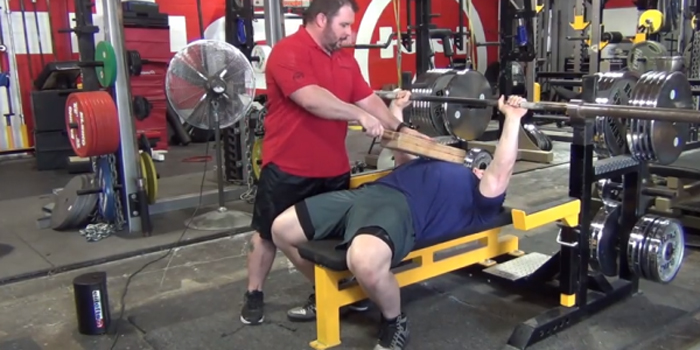
The dynamic effort method is one of three methods documented by Dr. Vladimir Zatsiorsky and popularized by Louie Simmons. The basic premise is that in order to create tension you must either lift as heavy as possible for that repetition range, lift submaximal weights as fast as possible, or lift submaximal weights for as many repetitions as possible. 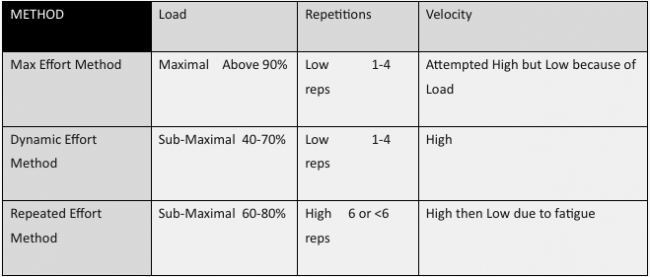
Now, there are many parameters that go along with these three methods. But, for the most part these three methods fit nicely in the conjugate periodization system. These three methods are sometimes broken down even further into the circa-maximal and a sub-maximal methods. Although, most of us found these methods implemented in the Westside barbell method of training, it has since been implemented with different terminology in other training methods such as the tier system, the cube method, and others. For this article I will concentrate solely on the dynamic effort method, specifically how it relates to programming for athletes in a sports setting.
Strength and conditioning is not powerlifting. The first thing that we all must understand is that lifting weights for powerlifting is specific physical preparation. Lifting weights for athletic performance is general physical preparation, or GPP. The term GPP may be the most misused term in the industry. The difference is specifically what the testable performance task is.
- I am going to benchpress to improve my benchpress if I am a powerlifter.
- I am going to benchpress to improve specific tasks on the field or court. EX: The bench press equals better pass blocking abilities.
So in this case, the dynamic effort method for athletic performance is by nature, more broad of a spectrum, due to the lack of necessary specificity for the skill.
The Dynamic Effort Method Dilemma
Three issues with traditional dynamic effort message a.k.a. speed squats, speed pulls, or speed bench for the thought of preparation.
1. Adaptability
For powerlifters, squatting or bench pressing two days per week is imperative for additional technique work, which is a very good attribute of dynamic effort work, But for athletes, the increased frequency of axial load on the spine, and the increased stress on the joints may not be necessary. Specifically, during certain seasons of the year. This may be more relevant for lower body exercises, but multiple days of horizontal pressing may add to the already prevalent imbalances most athletes arrive at college with.
2. Practicality
Whether you are in the small college, high school, or private sector; training athletes more that twice per week may not be a possibility. We all as coaches have been programmed to implement a 3-day or 4-day system for most sports. The combination of multiple seasons (with athletes being in-season), limited scheduling opportunities, and lack of appropriate coaching ratios; reduction of exposure is evident.
I have talked with Dan Stevens several times and we are both in agreement that athletes can get very strong and adequately prepared for their sport requirement training 2 days per week. We agree it is not optimal but certainly not an obstacle. It just becomes a mathematical equation. Here's an example from when I was at Denison:
- My weight room safely fit 30 athletes training at one time.
- There are 450 athletes I will need to train.
- I have 5 hours per day to train athletes 5 days per week equaling 25 training hours. Larger schools and coaches without secondary coaching and teaching assignments will have more.
- So if every athlete only trains once per week, that would mean I could host 15 full sessions IF each lifting group was evenly distributed.
- If every athlete lifts twice per week. That would mean I need to host 30 lifting groups. You see where I am going here? The solution? Less sessions, overlap sessions, have some sessions outside the weight room.
3. Mastery
How much time as coaches do we need to spend on the basic fundamental lifts? And, no matter how fundamental they are to your program, unless you are training lifters, they are merely GPP. Now General Physical Preparation is often misused when describing training methods, but please understand that physical preparation is only a small portion of the total athletic preparation of an athletes. This ratio becomes larger in the off-season, but still does not encompass the entire training protocol. This limits the amount of exposure to the weightroom specific skill and increases the highly technical skills for the athlete to master.
5 Ways to Enhance Speed Sets
1. Put Down the Barbell
Or at least do some different movement with them.
One of the most simple adjustments you can make as a coach is to perform your dynamic effort work as Explosive movements. Olympic lifts, throws, swings, jumps, sprints, bounds and hops. There is definitely a concern with loading these movement in relation to what quality you are actually trying to enhance. Here are just a few ideas of matching the movement patter with the exercise.
Lower Body
- Double Leg Push: Seated Jumps, Squat Jumps
- Double Leg Pull: Snatch, Clean, Swing, or Throw
- Single Leg Push: Hops, Jumps
- Single Leg Pull: Broad Jumps, Bounds, sprints
Upper Body
- Horizontal Push: Push Throws, Ballistic Push-Ups
- Horizontal Pull: Lying Throws
- Vertical Push: Jerks, Push-Presses, Push Throws
- Vertical Pull: Med Ball Floor Slams
The challenge is often imputing these movements within the overall program.
2. A More Meaningful Warm-up
Speed sets to work up to a max
The intention of moving the weight fast is as important as how fast the bar moves when developing explosive strength.
Strength Coaches: Bar speed is dictated by load but regulated by effort. The intent to move the weight fast regardless of load is the key.
— Mark Watts (@Elitefts_EduDir) October 25, 2014
An easy adjustment to get more out of each training session is to reinforce that the athletes performs each concentric contraction as fast as possible. This takes time for beginners and must be coached consistently. But, adding a few warm-up sets as the athlete works up can be beneficial. For example:
- 40%x3
- 50%x3
- 50%x3
- 60%x3
- 60%x3
- 70%x3
- 75%x3
- 80%x2-3
- 85% x 3-6 reps
One negative of adding speed sets is adding mutliple weight changes at the beginning of the sets.
3. Complex Training
Performing Dynamic Effort work in between Maximal Effort sets
As a small school strength & conditioning coach, you are often dependent upon your scheduling, staffing, and facility situations. Complex training, loosely defined as performing an explosive movement after a heavy movement, can also develop explosive strength. This is a crude way to incorporate Post-Activation Potentiation. For most coaches, the benefit that overrides any training effect is the ability to add density to the workout and increase work capacity. I also despise splitting the workout so that not all athletes perform the exercise in the same order. Depending on the size of the group, you can perform a dynamic moment (or two) after the max effort set. Here's an example for the squat:
- 4 Athletes: Spot, Squat, Load, Load, Repeat
- 5 Athletes: Spot, Squat, Jump, Load, Load, Repeat
- 6 Athletes: Spot, Squat, Jump, Prehab, Load, Load, Repeat
- 7 Athletes: Spot, Squat, Jumps, Antagoisnt, Prehab, Load, Load, Repeat
An even simpler way to incorporate this conceprt is to simply perform dynamic effort sets afte the max effort movement.
- Work up to a 3-5 rep max
- Use 80% of that max for 5 doubles
If you are using a percentage based system, it may look like:
- 85% for 3 sets of 3
- 55% for 5 sets of 3
Either way, don't be afraid to incorporate dynamic effort work after max effort work.
4. Total Body Template
There are plenty of good coaches that express avoiding performing multiple qualities on the same day citing a less-than-desirable adaptation for each. This is not just a WSBB methodology, Cal Dietz and Dr. William Kraemer have written about similar models in Triphasic Training and Optimizing Strength Training respectively.
4a. Addressing all 3 of Zatsiorsky's Methods Each Day
The most common template with utilizing dynamic, max effort, and repetition methods in each training session is Joe Kenn's Tier System. A common theme is performing a Total, Lower, and Upper Body movement under different methodologies.
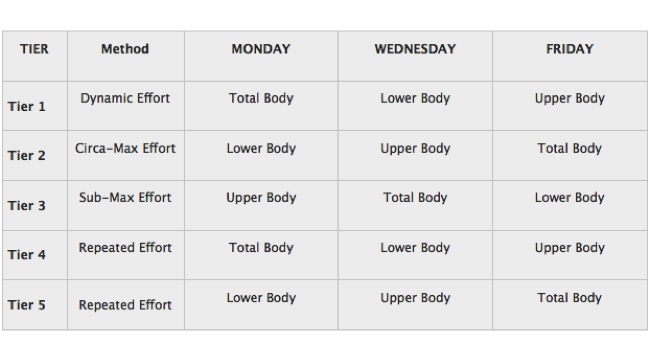 So a Dynamic effort movement will be performed everyday. The key with the Tier System is developing you r exercise pool with appropriate movements. This system works very well in a 3-Day per week program.
So a Dynamic effort movement will be performed everyday. The key with the Tier System is developing you r exercise pool with appropriate movements. This system works very well in a 3-Day per week program.
- Total Body: Deadlift
- Lower Body: Squat
- Upper Body: Bench Press
4b. Devoting a day for each method.... A Dynamic Day
Another adjustment that can be made in a team setting would be to perform all Dynamic Effort Movements on the same day. Essentailly an undulating load parameter system with three total-body days. This is similar to a Light-Heavy-Medium intensity wave only using Zatsiorsky's methods.
- MONDAY: Dynamic Effort (CNS is fresh from two days off)
- WEDNESDAY: Max Effort (Big Weight Wednesday)
- FRIDAY: Repeated Effort (Able to push athletes hard at the end of the week)
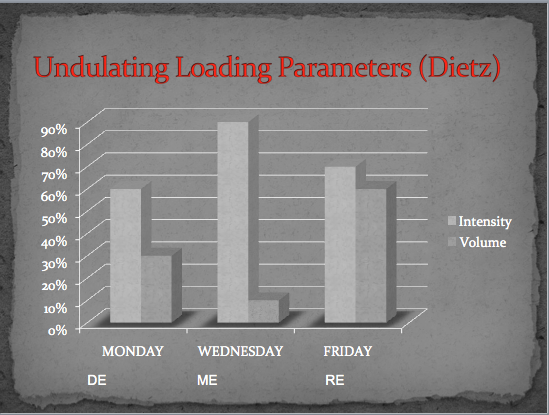 Cal Dietz had also referred to these days in terms of not only intensity but time-under-tension. Basically, days were split up by duration of activity whether it was resistance training or conditioning.
Cal Dietz had also referred to these days in terms of not only intensity but time-under-tension. Basically, days were split up by duration of activity whether it was resistance training or conditioning.
- Dynamic Effort: less that 5 seconds of work per set
- Maximum Effort: between 5-10 seconds of effort per set
- Repeated Effort: more than 10 seconds of effort per set.
Summary
I hope this may give you some alternatives for incorporating the Dynamic Effort Method in a team setting.
References:
The Coach’s Strength Training Playbook. Joe Kenn. Coaches Choice. 2003
Triphasic Training. Cal Dietz & Ben Peterson. Bye Dietz Sports Enterprises. 2012
THURSDAY
Conventional Deadlift with Straps
- 352 x5
- 352 x3
- 352 x3
supersetted w/ Box Jumps: 5,3,3,
Band TKEs on 12 in Box
Strong band for 10, 10









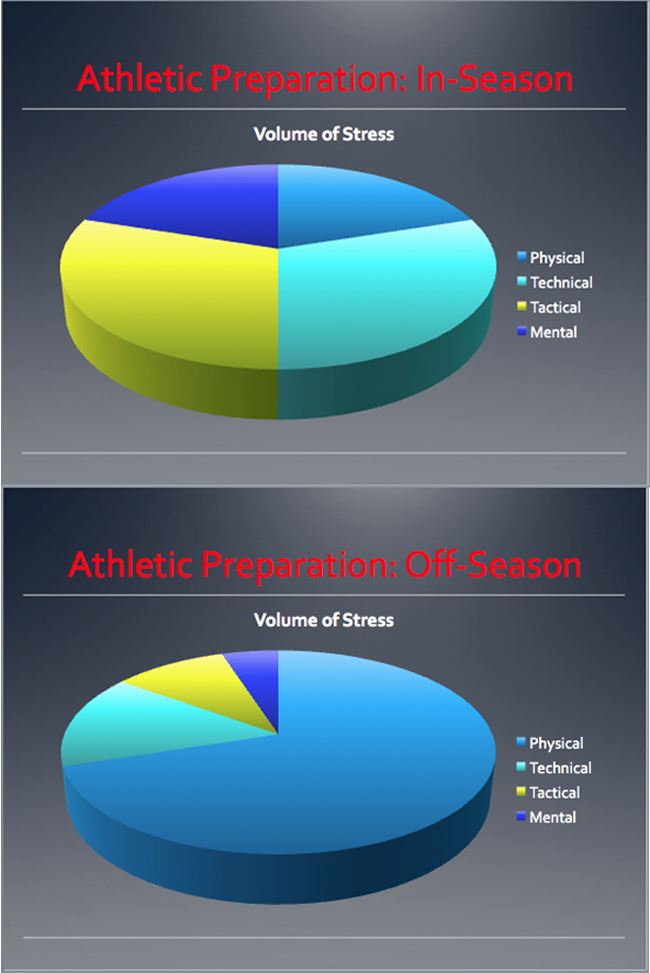
Side note, I had one of your former bball/softball athletes, Gretchen S, training in my gym a couple summers ago. I was very impressed with her technical abilities, focus, and work ethic in the weight room. Thanks for that too.
Thank you for the kind words. I really appreciate it and I hope the article can help. Yes, Gretchen is an outstanding person, a great athlete, and an extremely hard worker. She played basketball and softball at DU which was not easy from an academic standpoint. She was almost always "in-season" and still made great progress.
Thanks again, and I wish you the best.